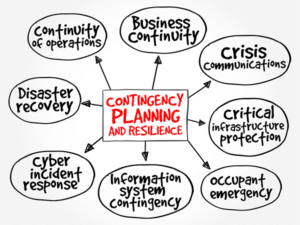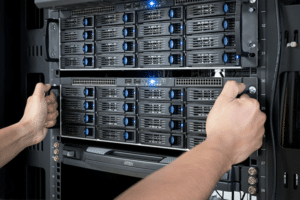
Network failures can significantly affect businesses and organizations in today’s interconnected world. The inability to access data, communicate with clients or customers, or conduct essential operations can result in financial losses and damage to reputation. Therefore, organizations must prepare for unexpected network failures by implementing robust contingency plans.
One key aspect of network failure contingency planning is establishing redundant network infrastructure. This involves creating multiple pathways for data transmission and ensuring that if one way fails, there are alternative routes available. Redundancy can be achieved using backup networks, such as secondary internet service providers or cellular networks, load balancing, and failover systems. By having redundant network infrastructure in place, organizations can minimize disruptions caused by network failures and maintain continuity of operations.
Another critical element of network failure contingency planning is the implementation of backup power systems. Power outages can render even the most sophisticated networks useless, leading to significant downtime and loss of productivity. Organizations should consider installing uninterruptible power supply (UPS) systems or generators that can provide temporary power during an outage to mitigate this risk. Also, proper maintenance and testing of these backup power systems are crucial to ensure their effectiveness when needed. By including backup power systems in their contingency plans, organizations can reduce reliance on external power sources and keep their networks operational during unforeseen events.
In conclusion, preparing for unexpected network failures requires a multi-faceted approach encompassing redundant infrastructure, backup power systems, disaster recovery strategies, communication protocols during failures, and employee training. By effectively implementing these key examples of contingency plans, organizations can minimize the impact of network failures and continue operations seamlessly, even in challenging circumstances.
Redundant Network Infrastructure
Redundant network infrastructure is critical to network failure contingency plans, ensuring uninterrupted connectivity and minimizing the impact of potential disruptions. It involves duplicating essential network components and implementing failover systems to maintain continuous operations in the event of equipment failures or other unforeseen circumstances.
One key aspect of redundant network infrastructure is network equipment redundancy, which involves deploying backup devices or systems that can seamlessly take over if primary equipment fails. This redundancy can be achieved through techniques such as using multiple switches, routers, or servers with built-in failover capabilities. By having redundant network equipment in place, organizations can mitigate the risk of single points of failure and ensure that their networks remain operational even if one device malfunctions.
Another crucial element of redundant network infrastructure is failover systems. These systems are designed to automatically redirect traffic to alternative pathways when a primary route becomes unavailable. They continuously monitor the status and performance of network connections and switch to backup routes in real time if necessary. Failover systems employ various mechanisms such as dynamic routing protocols, load balancing algorithms, or Virtual Router Redundancy Protocol (VRRP) to achieve a seamless transition between primary and backup routes without disrupting ongoing communications.
By implementing failover systems, organizations can maintain high availability by quickly rerouting data packets around failed links or devices. Redundant network infrastructure plays a vital role in network failure contingency plans by providing duplicate components and failover mechanisms that ensure uninterrupted connectivity during equipment failures or unexpected events. Network equipment redundancy ensures backup devices are available to take over operations if primary devices malfunction, reducing the risk of service disruption due to hardware issues.
Failover systems enhance resilience by automatically redirecting traffic along alternative routes when primary paths become unavailable. Together, these elements contribute to maintaining reliable and robust networks capable of withstanding potential disruptions while minimizing downtime and preserving seamless communication flow.
Backup Power Systems
Backup power systems ensure the continuous and uninterrupted flow of electricity to critical network infrastructure, guaranteeing its stability and resilience in the face of unforeseen power outages. These systems play a crucial role in a network failure contingency plan by providing backup power when the primary source fails.
Here are four key benefits of incorporating backup power systems into a network outage response:
- Reliability: Backup power systems, such as uninterruptible power supplies (UPS) or generators, provide a reliable source of electricity during emergencies. They can instantly kick in when there is a power outage, minimizing downtime and ensuring critical network equipment remains operational.
- Redundancy: With backup power systems, organizations can create redundancy within their network infrastructure. This redundancy ensures that even if one power source fails, another will seamlessly take over without causing any disruption to the network operations.
- Protection: Backup power systems protect sensitive equipment from damage due to sudden loss of electricity. Unplanned shutdowns can result in data corruption or hardware failures, leading to significant financial losses for organizations. With backup power solutions, these risks are mitigated as they provide an immediate and stable energy source.
- Flexibility: Backup power solutions offer flexibility by allowing organizations to choose between different options based on their specific needs and requirements. For instance, smaller businesses may opt for UPS devices that provide short-term battery backup during brief outages. At the same time, larger enterprises may invest in generators capable of supplying continuous power for extended periods.
Incorporating backup power systems into a comprehensive network failure contingency plan is essential for ensuring business continuity and minimizing the impact of unforeseen events like power outages. These backup systems play a critical role in maintaining uninterrupted operations during network failures by providing reliability, redundancy, protection against equipment damage, and flexibility in choosing suitable solutions.
Disaster Recovery Strategies
One crucial aspect of maintaining a resilient network infrastructure in the face of unforeseen disruptions is the implementation of robust disaster recovery strategies.
A disaster recovery strategy refers to a set of procedures and tools that an organization puts in place to ensure the continuity and rapid restoration of its network operations following a catastrophic event or system failure. These strategies minimize downtime, data loss, and service interruptions, allowing businesses to recover from adverse events quickly.
Network monitoring and alerting are critical components of an effective disaster recovery strategy. This involves continuously monitoring network performance and health and detecting anomalies or potential issues that may lead to system failures. By implementing advanced monitoring tools, organizations can proactively identify problems before they escalate into significant disruptions. Real-time alerts can then be sent to IT teams, enabling them to take immediate action and prevent further damage.
Another critical element in disaster recovery strategies is data backup and restoration. Regularly backing up essential data ensures that companies can restore their information quickly and efficiently, even if there is a complete system failure or loss due to a natural disaster. Data backups should be stored securely offsite or on remote servers, protecting against physical damage or localized incidents such as fire or flood. Additionally, organizations should regularly test their backup systems and processes to ensure they function correctly and can be relied upon when needed.
Implementing robust disaster recovery strategies is essential for maintaining a resilient network infrastructure. By focusing on aspects such as network monitoring and alerting, as well as data backup and restoration, organizations can minimize downtime, mitigate risks associated with disruptions, and ensure business continuity in the face of unexpected events.
Communication Protocols During Network Failures
Implementing effective communication protocols is crucial during network failures to ensure seamless coordination and information exchange amongst stakeholders involved in the recovery process. Communication protocols provide a structured framework for incident management and resolution, enabling organizations to minimize downtime and quickly restore network services.
The following are critical aspects of communication protocols during network failures:
- Clear communication channels: Establishing clear communication lines is essential to ensure that all relevant parties can effectively communicate during a network failure. This includes defining primary and secondary modes of communication such as email, phone calls, or instant messaging platforms.
- Incident reporting procedures: Communication protocols should outline the steps for reporting incidents and initiating the incident management process. This involves identifying who should be notified, what information needs to be provided, and how incidents should be categorized based on severity.
- Emergency response team roles and responsibilities: Clearly defining the roles and responsibilities of the emergency response team members ensures efficient coordination during network failures. Each team member should understand their specific tasks, such as assessing the impact of the loss, implementing temporary fixes if possible, or escalating issues to higher levels of authority.
- Timely updates and status reports: Regular updates and status reports are vital for keeping all stakeholders informed about the progress of resolving network failure. Communication protocols should specify how often updates should be provided, what information needs to be included in these reports, and who will be responsible for generating them.
Organizations can effectively manage incidents and minimize disruptions to their operations by establishing robust communication protocols during network failures. These protocols enable swift collaboration among stakeholders involved in resolving the issue while ensuring everyone can access timely information for making informed decisions.
Employee Training and Preparedness
Organizations must prioritize employee training and preparedness to ensure adequate response and recovery during network disruptions. This involves providing employees with the necessary knowledge and skills to handle network failures efficiently.
Training programs should educate employees about business continuity measures and the importance of following contingency plans. Employees should be trained on the specific steps they need to take when a network failure occurs, including identifying and reporting the issue and implementing backup systems or alternative communication methods.
In addition to training, organizations should emphasize the importance of regularly testing and evaluating contingency plans. This allows employees to familiarize themselves with the procedures in a controlled environment and helps identify potential weaknesses or gaps in the program.
By conducting drills or simulations, organizations can assess their employees’ readiness and make necessary improvements to enhance their response capabilities. Furthermore, incident documentation is crucial for capturing details about network failures, such as their causes, impacts, and resolution strategies.
This documentation is valuable for future reference and enables organizations to learn from past experiences. By analyzing these incidents thoroughly, organizations can identify trends or recurring issues requiring additional training or adjustments to their contingency plans.
What are the common causes of network failure?
Common causes of network failure include hardware failures, software bugs, human errors, power outages, natural disasters, and cyberattacks. These factors can disrupt network connectivity, cause data loss, and compromise security.
How long does it typically take to restore network connectivity during a failure?
The time taken to restore network connectivity during a failure depends on various factors, such as the nature and severity of the loss, the complexity of the network infrastructure, and the efficiency of the contingency plan.
Can network failures be avoided entirely or prevented?
Network failures cannot be avoided entirely or prevented due to various factors such as hardware malfunctions, software bugs, and external events. However, implementing robust contingency plans can minimize the impact and downtime caused by these failures.
Are any specific legal obligations or compliance requirements related to network failure contingency plans?
Legal obligations and compliance requirements related to network failure contingency plans vary depending on the industry and country. These requirements ensure data protection, business continuity, and customer rights in case of network failures.
What are the potential financial impacts of a network failure on a company?
The potential financial impacts of a network failure on a company can be significant. They may include lost revenue, decreased productivity, increased operational costs, data breach-related expenses, reputational damage, and legal liabilities.







No comment yet, add your voice below!